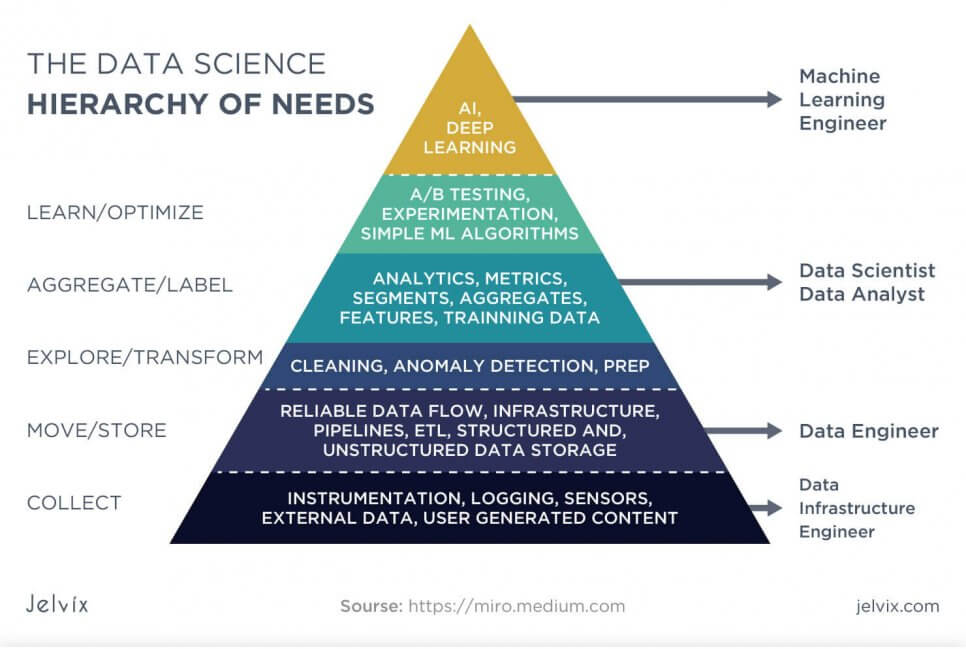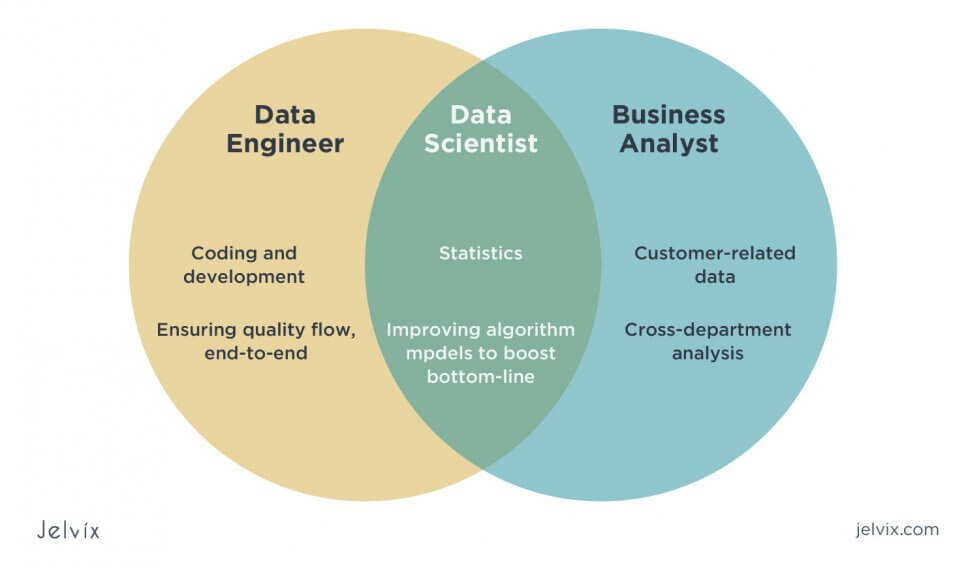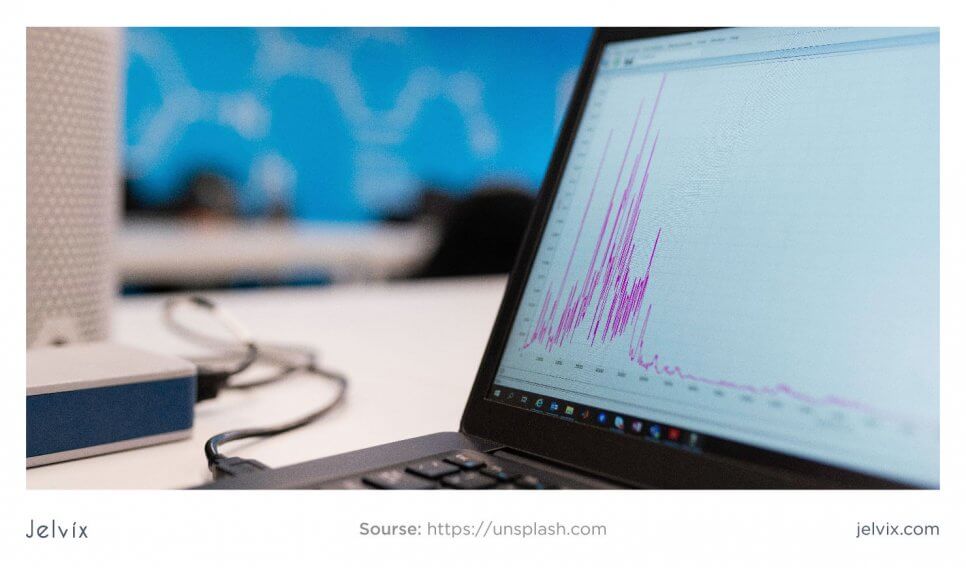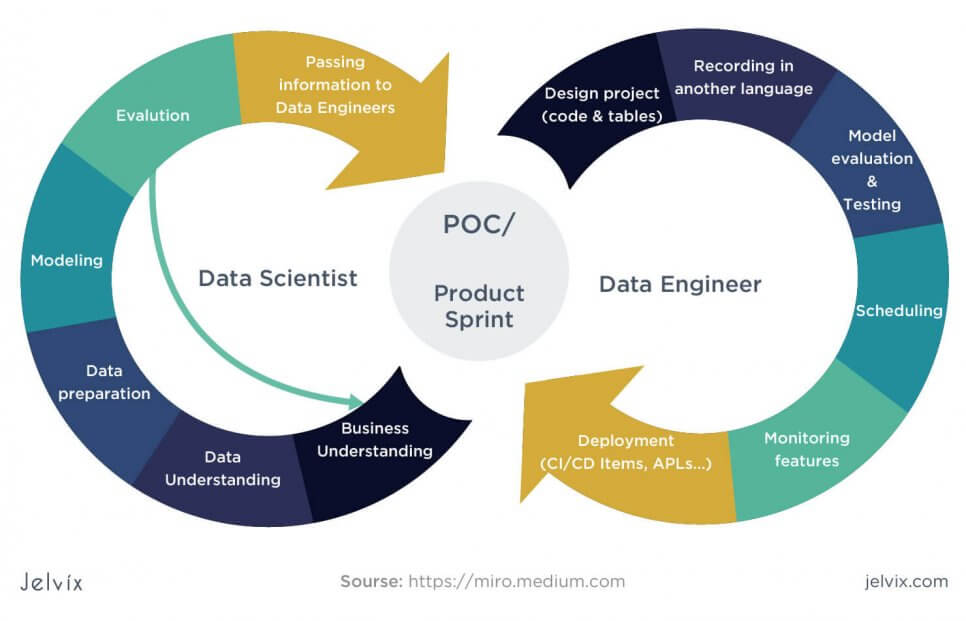It’s been not that long since the conversation about differences between data scientists and data engineers started. A field that used to be one of the most ambiguous in tech is getting enormously more popular every year. Positions, roles, responsibilities are still maturing.
However, the main differences have already emerged clearly. This article will share our experience of assembling data science and data engineering teams and give insights on their tangible job responsibilities and roles.
Why Distinguish Between Data Engineers and Data Scientists
According to IBM’s CTO report, 87% of data science projects are never really executed. 80% of all data science projects end up failing. Mainly, this happens due to the market’s inability to distinguish data scientists and engineers.
Even now, it’s surprisingly common to find articles online about data scientists’ responsibilities when some of them belong to the data engineer job description. A lack of understanding of what data scientists can and cannot do leads to a high failure percentage and common burn-out.
The thing is, neither data scientists nor engineers can act on their own. Scientists hugely depend on engineers to provide infrastructure. If it’s not set up correctly, even the most skilled scientists with excellent knowledge of complex computational formulas will not execute the project properly.
The data development and management field include many specialties. Data engineers and scientists are only some of the roles necessary in the field. These positions, however, are intertwined – team members can step in and perform tasks that technically belong to another role.
The exact team composition depends on business size:
- For startups: all the data-related work can be accomplished by a small team of 1-3 people;
- For small businesses: companies with 10-50 employees can get by with data engineers and data scientists;
- For large companies and enterprises: as the volume of data grows, you need the full data management team to keep track of complex processes. You can visualize the entire pyramid taking a look here:
Data Engineer vs. Data Scientist: Areas of Work
What is a data engineer? A data engineer is focused on building the right environment and infrastructure for data generation. The goal is to create and collect data that will later be used for comprehensive analysis.
The primary data engineering definitions
- Data pipelines: data engineers are responsible for creating ways (pipelines) in which the data travels through the infrastructure.
- Data modeling. Engineers create conceptual data representations – visual models, architectures, and dashboards.
- Data wrangling. Engineers make sure that the data used in the infrastructure is valid and high-quality. We have created an entire guide on data quality that we recommend you check out since it’s a crucial competence for data engineers.
Read more about the data quality definition, the challenges of data quality management, and ways to solve them.
A data scientist is focused on interpreting the generated data. It’s a person who helps to make sense of insights that were received from data engineers. They rely on statistical analysis and advanced calculations to derive conclusions.
Data scientists’ responsibilities lie at the intersection between business analysis and data engineering, focusing on analytics from one and data technology from the other. This is where the difference between data analytics vs data science lies. Data scientists also need to have software development expertise, which is necessary for analysts.
So, technological expertise is the main difference between data analysts and data scientists.
It’s not an Either/or Choice
When a company wants to assemble a data management team, they shouldn’t choose between data engineers and data scientists. Both roles are highly important, and one can’t function well without the help of the other.
Without data engineers, there will be no infrastructure that can consistently supply the data scientist team with high-quality data. They are responsible for designing and maintaining the infrastructure. If it fails, data scientists have nothing to analyze.
On the other hand, even the best infrastructure will be pointless if it receives no interpretation. Data scientists notice trends within data and derive tangible conclusions – something companies can immediately use in business management, marketing, and innovation.
The Working Process in Data Science vs Data Engineering
If you plan to assemble a data management team, you need to have a clear idea of its day-to-day actions. As early as the hiring stage, you need to understand clearly what’s the routine for data engineers and scientists – and the differences between them.
What is Data Engineering?
There’s a common opinion among data engineers and overall developers who work in data management teams, that a data engineer is just a more specific backend engineer position. Questions like how to become a data engineer are often answered with “get good in data management as a backend engineer first” – all to understand the overall development logic.
Take a look at a typical data pipeline example:
It’s true that data engineers’ responsibilities sometimes intersect with a typical backend developer or database manager; however, there are some differences.
- Data engineers manage all kinds of complex data. An entry-level data engineer learns how to build the architecture for a data house, set up a data model, and connect it to business intelligence. Since data is the focus of such an expert, a data engineer is a go-to person for any data architecture questions.
- Data engineers provide the business with strong analytics on data use. Such an expert analyzes which architecture is necessary for the software, predicts risks and challenges, and creates mechanisms for reporting and analytics.
- Data engineers set up high-quality standards for data from the very beginning. We have a guide on data quality – take a look to find out what makes data valuable or useless.
Another question that people often have about data engineers’ work process is: why would someone need a data engineer if they already have a good backend team? The thing is, the requirements for data use are growing. Current data architecture standards are incredibly high – to fit them, you need specialists with an undivided focus on data architecture.
How Does Data Scientist Work?
Even though data engineers do a lot of analytical work while setting up the infrastructure, the real, hard-core analytics lies on data scientists’ shoulders. They are already equipped with the infrastructure, set up by data engineers, and can focus mainly on analysis and interpretation.
The primary purpose of a data scientist is to solve a data problem. The problem is usually stated in a business language (for instance, you need to find user preferences to build a real-time recommendation system).
Data scientists are the ones who translate the problem to the mathematical language, find a tangible solution, and convert it back to business-related interpretation. They also know the basics of database development and can execute simple solutions on their own – which is again, a difference between data science and data analytics.
The data science problem-solving process can be roughly grouped into six steps:
- Framing the problem. The data scientists have to research the issue of the client as well as needs and risks. After getting a clear idea, the next step is to re-word the problem into a mathematical form.
- Defining what data is useful to solve the problem. Data scientists understand how the needed data can be obtained with the current infrastructure. If there are changes that should be made to the architecture, they cooperate with data engineers. The result of this step is collected information.
- Processing the data. Even a high-quality infrastructure can’t provide ready-to-go information. Data scientists need to convert formats, spot errors, detect missing values, and organize records. The goal is to collect data in a comfortable and easy-to-view framework.
- Defining the high-level insights. Data scientists take a look at the data from a bird-eye view. Their goal is to detect the biggest trends first and write down the high-level qualities of a dataset.
- Diving deeper. By using machine learning, automated frameworks, and tools data, scientists perform an in-depth analysis. They detect smaller trends within the data and determine how they correlate with the earlier identified bigger picture.
- Finalizing the results. Mathematical trends and relations have to be translated into actionable business values. The data scientist’s final goal is to convert findings into a language that’s easy to understand for the stakeholders. It requires deep business understanding and strong analytical capacities.
The result of a data scientist’s work is a complete analysis with clear and tangible insights. With such a report, a company can implement changes to its operations and measure them precisely. The data scientist may then reanalyze data to see how the process changes translated to differences in data.
Data Engineering vs Data Science: Role Requirements
After understanding the workflow of both data engineers and data scientists, we can summarize their responsibilities briefly. It will help you recruit experts and build the cooperation process within the department.
The result of cooperation between data engineers and scientists is the story told to stakeholders and other departments. This is why raw data gets through several layers of processing organization and interpretation. To achieve clarity and precision of these insights, data engineers and scientists should cooperate, improve tools, infrastructure, and grow skillsets.
Tools Used by Data Engineers and Data Scientists
Since data engineers’ workflow is roughly similar to that of a data manager and backend engineer, it’s no surprise that they often use similar tools. Here’s a brief rundown of the necessary software.
- Database management system: DBMS lies at the core of the data architecture. We have a full guide to relational vs non-relational databases and their management systems – take a look since it’s the fundamental concept of data management. The most common DBMSs are MySQL, SQL Server, PostgreSQL (relational databases), Mongo DB, DocumentDB, Cassandra (non-relational databases).
- Data processing and cluster computing tools. Software like Spark and Hadoop is used both by data engineers and data scientists. It helps organize data and maintain high-quality. We provide a comparison between Spark and Hadoop on our blog, so check it out as well.
- The most common programming languages used by data engineers are Python, C++, Java, and Scala.
Since a data engineer’s role is closer to software engineering, they will also be using many developments and DevOps tools to ship the results of their work. They can make use of backend tools and frameworks as well.
Tools used by data scientists
Data scientists are focused on the analytical aspects of data management much more than on the technical one. So, they make use of statistical tools, machine learning frameworks, computing software, etc. Let’s do a quick rundown of the most popular instruments.
- Instruments for managing large data volumes: data scientists need software that can organize information. We usually use Pandas – it’s a great open-source library for data science.
- Real-time processing tools. Data scientists can speed up the processing with Apache Storm, Apache Kafka, Amazon Kinesis, and other real-time platforms.
- Business intelligence: instruments like Tableau, Microstrategy, QlikView, and others allow formatting data analysis and formulas for complex computations.
- Scientific analysis and computation Python packages: we already mentioned Pandas, but there are other packages as well. For instance, NumPy, Matplotlib, and Scikit-Learn are used to write machine-learning data processing frameworks and execute complicated calculations.
The toolsets for data engineers and data scientists often overlap, but still, there are many differences. Generally, engineers are focused on instruments that let set up Extract, Transform, Load flows (ETL flows) while data scientists often turn to statistical frameworks and packages.
Demand on Data Engineers vs Data Scientists
According to Glassdoor’s search results, data engineers’ number of openings is five times higher than for data scientists. Although both positions are among the most requested ones, the difference is noticeable.
The reason is simple: to get a data infrastructure running, you need many data engineers. As for data scientists, several experts with strong automation expertise are enough to interpret large data volumes.
Cooperation Between Data Engineers and Data Scientists
When we described both responsibilities and workflows, we mentioned that continuous cooperation is critical. However, it’s better to clarify where precisely data engineers and scientists can help each other and what issues typically come up in the process.
Challenges of Cooperation Between Data Scientists and Engineers
The main problem is the lack of understanding of the responsibilities of the other party. If the organization doesn’t define clear roles for each data expert, the team will quickly become confused and won’t cooperate efficiently. This lack of understanding inevitably causes a lack of respect for the other party and decreases cooperation efficiency.
Another problem is more global: the overall misunderstanding between all data specialists and the rest of the team. If data scientists and engineers equally struggle to understand their place in the workflow, their colleagues will also misunderstand the responsibilities and the communication will not be productive at all.
How to introduce transparency to cooperation?
- Use a coordinated project management platform to track all data related task;
- Have a specified document that defines the roles and responsibilities of all team members;
- Hold regular joint meetings to discuss the state of the infrastructure, recently found out insights, etc;
- Give both parties opportunities to contribute to and suggest improvements.
How to synchronize data scientists and engineers with the entire team?
- Educate developers on the importance of data management. It’s essential to explain why data is vital to all areas of software development. If data scientists also cooperate with other departments, experts from those fields should join the workflow.
- Encourage interactions of the data management team with product design, marketing, and sales. Data insights are critical in those fields. Plus, zooming out of purely technological problems improves experts’ business intelligence and leads to higher analysis quality.
- Encourage cross-cooperation. A common problem with data scientists and engineers’ collaboration is the lack of understanding of engineering and analytical aspects. The company should encourage the exchange of expertise, invest in self-improvement, and ensure that everyone is on the same page.
Data engineers and data scientists have a lot of common points with other areas of software development. The data engineer’s responsibilities can be similar to a backend developer or database manager, leading to confusion in the team. Data scientists face a similar problem, as it may be challenging to draw the line between a data scientist vs data analyst.
It’s important to clarify where the responsibilities of one position begin, and those of another end.
The Bottom Line
Both data engineers and data scientists are crucial for maintaining long-term and efficient data infrastructure. The first step to kick-starting efficient cooperation is to clearly define roles and responsibilities. Hopefully, this article helped you draw a line between the two parts and envision the responsibility distribution.
Of course, the exact division of these roles depends on the project’s needs and personal skills. You can make changes to the conventional description of responsibilities. It’s fine as long as these distinctions are drawn clearly.
If you are interested in hiring a balanced data science vs engineering team, where members already have established roles, communication practices, and years of collective experience, contact us. Get in touch with data experts and take an in-depth look at your project.
Need a qualified team?
Use our talent pool to fill the expertise gap in your software development.

















